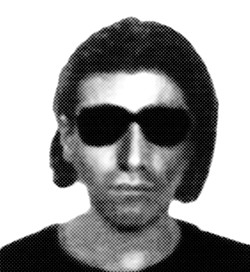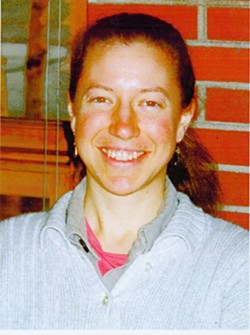[{
"name": "Ad - Medium Rectangle CC01 - 300x250",
"id": "AdMediumRectangleCC01300x250",
"class": "inlineCenter",
"insertPoint": "8",
"component": "2963441",
"requiredCountToDisplay": "12"
},{
"name": "Ad - Medium Rectangle LC01 - 300x250",
"id": "AdMediumRectangleCC01300x250",
"class": "inlineCenter",
"insertPoint": "18",
"component": "2963441",
"requiredCountToDisplay": "22"
},{
"name": "Ad - Medium Rectangle LC09 - 300x250",
"id": "AdMediumRectangleLC09300x250",
"class": "inlineCenter",
"insertPoint": "28",
"component": "3252660",
"requiredCountToDisplay": "32"
}]
It has been almost exactly 10 years since Andrea Lynn Hug took her last walk, to take in the scenic bluff views above Montana de Oro’s Spooner’s Cove.
The park’s name translates as “mountain of gold” and it comes from the poppies and wildflowers that flourish with the spring rains. On Hug’s final walk, however, conditions would have been more like those on a recent day, with a snapping chill in the air, lupine and coastal buckwheat in bloom, and a fine dust covering both the trail-hugging dune scrub and the Monterey shale that gives the place its rugged elegance.
For Hug, an accomplished violinist who had traveled the world, there would certainly have been beauty along the walk, but there would also, most
certainly, have been terror.The 30-year-old woman’s body was discovered at the rocky bottom of a cliff the next morning, only hours after a friend reported she failed to return from her planned hike and had missed an evening appointment at a yoga center.
Hug’s sunglasses and keys were found at the top of the cliff; a sweater was located nearby. A bloody mark was identified on a point down the cliff, directly below her belongings. But, strangely, Hug’s body was found 200 feet to the north.
From the start, the police inquiry into Hug’s death faced challenges. For one thing, she wasn’t a resident; she lived and worked at a holistic massage school in Humboldt County and was in the area only for a visit. Another problem: Among the few who saw her in her final hours were some German tourists, and they would soon return home.
According to news reports from the time, detectives initially worked her death as a potential homicide. They sealed the site for several hours after she was found and strung yellow tape around her Ford Escort to prevent tampering.
But, later that day, Lt. Patrick Hedges, who is now the sheriff, was already telling reporters detectives presumed she’d died from an accidental fall.
“Pending any autopsy results to the contrary, indications are, at this time, this is an accidental death,” he was quoted as saying in the Telegram-Tribune the next day.
It was an approach to a case that seemed to defy established police procedure. According to Lawrence Kobilinsky, chairman of the Department of Forensic Science at John Jay College of Criminal Justice in New York City, standard procedure would approach such a death as a homicide until it was proven otherwise.
“I think you always have to treat it as a possible homicide,” he said, “even if it looks like an obvious accident or a suicide.”
But the investigation into the death of Andrea Lynn Hug has never been routine.
A missed call
Just as Hedges predicted, Hug’s death was later classified as accidental. But even that process was strangely complicated. The death certificate making the decision official wasn’t filed until eight months after her death, an unusually long time.
It’s not unusual for an original certificate to be marked as “pending investigation” because death certificates must be filed promptly, but amendments with final decisions generally are filed within a month.
One police source said the paperwork from the coroner’s office was apparently misplaced. The deputy coroner who signed the death certificate said he could not recall the Hug case in any detail.
Regardless, that was where matters remained for five years: Andrea Lynn Hug officially died of an accidental fall.
Her case, however, never sat right with some in the department.
In 2003, in a move officials at the time described as unprecedented, sheriff’s officers reopened her case. It was, they decided, a homicide after all.
According to reports at the time the case was reopened and recent interviews with those involved, the case status was changed not long after a supervisor who had been in charge of the case moved on to another assignment.
One officer identified the supervisor as Steve Bolts, who was a lieutenant at the time with authority over the detectives’ division. Bolts is now the undersheriff, the second-ranking position under Hedges.
Bolts, however, recently said he was never directly in charge of Hug’s case. And he said that, once the case was re-examined, he was among those who recommended it be reopened.
“This case has haunted the investigator, for lack of a better word, for years,” then-Capt. Gary Hoving told the Tribune, at the time the case was reopened. While reopening the case was a bit of an embarrassment, he said, “Our integrity is worth a lot more than our pride.”
Hoving has since retired but he said in a recent interview that the Hug case still bothers him.
“It pains you to know that we lost so much time on a case because it was not done thoroughly the first time or the wrong conclusion was arrived at.”
He said that, in early 2003, two investigators came to him separately and expressed interest in re-examining the Hug case.
According to accounts from several people involved in the case, shortly after it was re-examined, investigators found numerous indications that Hug’s death wasn’t an accident.
For one thing, there was the location of her body. Hug’s body appeared to have been dragged about 200 feet north of where she had initially landed. Her body was found in a crevasse, out of sight.
As one person involved in the case explained: “Dead people don’t crawl.”
Investigators at first apparently dismissed the relocation of her body as the possible work of a large animal, even though there were no obvious bite marks. Alternatively, they thought her body might have been moved by the tide, but a later look at the tidal record in 2003, when the case was reopened, discounted that idea.
But an even more glaring indication came in an autopsy report, which described Hug as having a shattered hyoid bone.
The hyoid is a horseshoe-shaped bone in the throat, and investigators are taught to view a fractured hyoid as a sign of likely strangulation. The connection is so well established, it’s a tenet of medical investigation textbooks.
And Hug’s hyoid bone wasn’t merely fractured; it was broken in its center, an even stronger suggestion of strangulation. A hyoid bone fracture is a clear indicator of homicide, Kobilinsky said.
“If there was damage to the bone, that could not be explained by the fall,” he said. Based on a short description, Kobilinsky said Hug’s case sounded “mysterious,” “suspicious.”
Hug’s name resurfaces
It’s been nearly 10 years since Andrea Hug was killed. Detectives have continued to work the case, gaining progress sporadically. But, aside from a bulletin about the case posted on the sheriff’s website, the name of Andrea Hug hasn’t been heard much in SLO County in the past five years.
That situation changed thanks to another, more recent, embarrassment within the sheriff’s department.
In 2006, Hedges and Bolts secretly videotaped a meeting Hoving had with one of his officers. Hedges has said publicly he authorized the surveillance as part of an investigation into alleged misconduct, never substantiated, within the narcotics division. Other accounts held he approved the eavesdropping after he became concerned Hoving was being disloyal and making fun of him.
The state Attorney General’s office investigated the incident and decided not to prosecute Hedges. However, Hoving filed a federal civil rights lawsuit against Hedges, Bolts, and the county, which the county settled recently, with a $660,000 payment to Hoving.
It was in a transcript of a deposition from the county’s own investigation into the spying incident that Andrea Hug’s name returned to the public record.
The transcript stemmed from an interview with County Human Resources official Dori Duke. In it, she recounts an unusual conversation she had with Hoving. The conversation occurred shortly after he’d discovered he’d been spied on. Hoving wanted to make clear that he was concerned for his own safety. He told Duke he wanted it known that he wasn’t contemplating suicide, in case he should go missing.
That’s when he raised the Andrea Hug case.
In the transcript Duke said Hoving expressed concern about the sheriff’s department “covering up a murder, the Andrea Hug case, and [he] went into details about that, that they changed the cause of death to homicide on that.”
She continued: “ ; then he described some more of the details about the Andrea Hug thing and how, you know, and some of the evidence that, that they had in the investigation and why it was ever an accident as the cause of death was beyond him and that it was changed to homicide, that the guy [who] was involved as a suspect in that murder was a former cop in Grover Beach.”
Hoving, asked about the conversation, confirmed the essence of it, with one notable exception: He stressed that he does not believe there was any intentional cover-up.
“I can guarantee you,” he said, “I in no way, shape, or form believe the Andrea Hug case was deliberately suppressed or changed. It was just sloppy police work.”
Bolts also denied that there was any cover-up involved. He said he suspected Duke misheard Hoving.
“That’s absolutely not true,” he said. “There was no cover-up nor would there be any reason for a cover-up and I don’t believe Gary Hoving ever said that.”
Duke, however, confirmed the transcript reflected the conversation she recalled.
Top suspect
Whether there was a cover-up or a screw-up, what’s certain is that Hug’s body had been buried in an Illinois cemetery for five years before her death was officially reclassified as a homicide in 2003. Now they had a huge question to answer: Who killed Andrea Hug?
The renewed investigation turned up three suspects: two convicted killers and one former Grover Beach cop. But in the years since, the convicted killers have been ruled out and the main suspect is still the former cop.
Rex Krebs was sitting on death row in San Quentin when investigators interviewed him about Hug’s death.
Krebs fit the profile. He had raped and killed two young female students: one in November 1998 and then another in March 1999. Their
bodies were found on Krebs’ Avila Valley property and both had died of asphyxiation.
But when investigators interviewed Krebs they quickly ruled him out.
There was another suspect: Peter Derks, who was sentenced to life in prison for the 1985 rape and murder of a 23-year-old Cuesta
College student. Like Hug, the girl was found in Montana de Oro, where she had been strangled. Derks was not arrested until 2004 when DNA evidence finally linked him to the murder.
But Derks, too, was not the man investigators were looking for in Hug’s cold case.
So how did a former cop become a suspect among convicted rapists and murderers? The short answer is that detectives believe he was there, at the scene. What linked him to the crime? Some foreign tourists, and a memorable van.
The key witnesses were tourists from Germany who reported seeing a man with Hug, in the park, the day before she was found dead. They also reported seeing a Chevrolet van with a green stripe at the scene.
In April 2005, SLO sheriffs searched a home in San Luis Obispo. Although investigators would not reveal at the time whether they’d gathered any evidence in the search, a month later they were on a plane to Germany with a stack of photos.
In May 2005—seven years after Hug’s death—the tourists were located through Interpol and shown a “six pack” of photos. Also called a photo array, the six pack had a photo of the suspect and five other look-alikes. This particular pack had the former cop, who had been identified through the van.
It wasn’t any ordinary van. The van was the former property of a government agency. Detectives were able to find out who had purchased the van from the agency.
Even though seven years had passed, detectives say the tourists immediately identified the man. Now investigators had someone who had been seen with Hug and who was perhaps the last person to see Hug alive.
The man whom they identified without hesitation was a former Grover Beach police officer. Sheriff’s officials recently confirmed that their main suspect was a cop for a “brief time” in the 1980s. His name, however, is being kept under wraps, as are details about when he was a cop and where he is now.
But sheriff’s officials seem certain they have found Hug’s killer. When asked what they need to convince a court, they said, “We’re not far off.”
According to other news reports, the suspect was well aware that he was being investigated. Additionally, he has a minor criminal record and previous arrests.
The police report describes him as 5 feet 8 inches tall, 170 pounds, with black hair, sunken cheeks, and a large pointed nose. One report said he frequented San Francisco.
So why did nothing surface originally?
According to the sheriff’s department, witnesses were interviewed as soon as Hug’s body was found, but investigation ceased when the coroner and sheriff’s officials ruled her death was an accident.
Bolts said the department did not identify the former police officer until 2003. In other words, they did not know that the man whom witnesses described had been a police officer, when they decided Hug’s death was an accident.
But other questions remain unanswered.
When exactly was he first identified? What was found in his home? Did he have any connection to Hug? Why has there been no arrest in the five years since the case was reopened?
While Hug’s file is open, investigators’ mouths are staying shut on those and other questions.
Chasing the Hug investigation
According to Hug’s death certificate, before she was killed she worked at the Heartwood Institute, a massage school in Garberville.
Hug worked there only three years, the same period she had lived in Garberville. A current Heartwood employee said she vaguely remembered Hug and had been contacted by the sheriff’s department when the case was reopened, but could not recall what questions they asked. She recommended New Times speak with another employee who would likely have more information, but that employee did not respond to repeated phone calls.
An employee at the G.L. Hills Funeral Home in Des Plaines, Ill., immediately remembered the Hug case and how SLO County officials had come to exhume her body.
Considering that Hug’s remains were dug from the grave in order to prove a murder had been committed, SLO officials went in and out of Des Plaines without raising so much as a newspaper article. A reporter from the Des Plaines Times said neither she nor anyone else at her paper could recall Hug or anything concerning the case.
The Des Plaines Police Department and Cook County Circuit Court also had no information; representatives said the exhumation and investigation would fall outside their jurisdictions.
Hug’s father, Gerald Hug, said police have kept him informed of the status of the investigation but declined to say more, saying he’s concerned it could impede the investigation.
Sheriff’s officials, however, did not seem so reticent, confirming that their suspect is a former police officer.
In a small windowless room, discussing cold cases that percolate occasionally for routine audits, sheriff’s officials recently said the Hug case was one that some investigators just couldn’t shake. According to Detective Sgt. Aaron Nix, “it bothered them.”
Asked about the personal toll Hug’s case and other cold cases like it take, a roomful of investigators and detectives silently nodded.
And for now, that’s where things stand. Sheriff’s officials believe they are close, but lament the time they lost.
As Nix noted: “Seven years is a hard obstacle to overcome.”
Timeline
1998
October: Andrea Hug’s body found at base of cliff in Montana de Oro State Park. Ruled an accident within days.
1999
July: Hug’s death certificate officially registered. Lists cause of death as accidental caused by blunt force head trauma.
2003
January: Case re-opened.
April: Body exhumed from Illinois cemetery.
July: Sheriff’s Department reports that case is re-opened as a homicide.
2005
April: Search warrant executed on San Luis Obispo residence.
May: German tourists identify suspect in photo array.
2006
Gary Hoving tells Human Resources Deputy Director Dori Duke he fears for his life. Among the reasons he cited are the Andrea Hug murder, Duke told a federal judge.
Managing Editor Patrick Howe can be contacted at [email protected]. Writer Colin Rigley can be reached at [email protected].
Latest in News
Readers also liked…
-

Coast Unified teachers upset over new position's salary and qualifications
Oct 20, 2022 -

SLO police identify alleged driver who hit and killed couple
Dec 22, 2022 -

When the levee breaks: Oceano residents, county officials walk a tightrope of regulations to manage Arroyo Grande Creek, which some say led to the levee's failure in January
May 18, 2023











